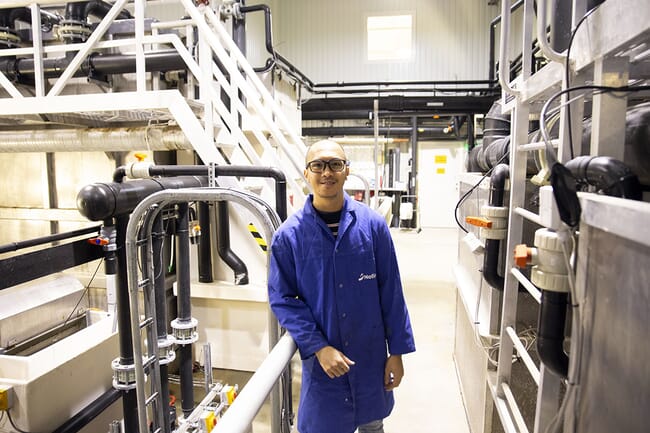
© Kevin Still, Nofima
So argue Nofima scientist Carlo C Lazado and Chris Good of The Conservation Fund’s Freshwater Institute, who recently published an article titled Survey findings of disinfection strategies at selected Norwegian and North American land-based RAS facilities: A comparative insight. Work on the survey was conducted at the CtrlAQUA Centre for Research-based Innovation.
There are strict hygiene standards in land-based facilities. Disinfection is an important safety measure that prevents the spread of pathogens, which can cause disease in the fish. The publication, which is based on responses to a survey, shows differences and similarities in the disinfection of equipment at 25 modern RAS facilities in Norway, the US and Canada.
“In Norway, the production of salmon in RAS facilities is increasing rapidly, which is why we are now evaluating current practices so that the industry has a basis on which to adjust future procedures,” says Carlo C Lazado.
Disinfection protocols
The first part of the survey is about general disinfection strategies for equipment. The majority of Norwegian respondents, and more than 90 percent of the North American respondents, state that they use standardised protocols when disinfecting. In other words, they follow the manufacturer’s recommendations for use.
“Many factors influence how effectively the equipment is disinfected, such as the type of materials, temperature and humidity. A disinfectant product must be practically tested in several facilities in order to find out how effective it is under varying conditions. The survey reveals that many people are not aware of how effective the disinfectant is for their RAS facility,” says Lazado.
Types of disinfectants
The scientists then asked what type of disinfectants are used at the facilities, and why. The answers show that a number of different disinfectants are used in all facilities. In Norway, peracetic acid-based disinfectant is mainly used, but also chlorine. In North American facilities, chlorine and sodium hypochlorite are predominantly used. The difference may be due to the fact that far more products based on peracetic acid are approved in Norway, compared to those based on chlorine. All the respondents stated that effectiveness against pathogens and user safety are the main criteria regarding the choice of agent.

© Terje Aamodt, Nofima
Regional differences
Part three of the survey is about the disinfection of equipment in the facilities.
Approximately 40 percent of Norwegian respondents state that they disinfect tanks and pipes after each production cycle, while 60 percent of North American respondents, said that they do the same.
The period of contact with the disinfectant varies between 12 and 24 hours at the Norwegian facilities, while there are greater variations in North America. There, the period of contact is from 1 to 24 hours.
“Greater variation in the period of contact may indicate that they have more structured strategies, and somewhat more experience regarding the effect of disinfection. This is reflected in the fact that most facilities in North America have longer operating time compared to the Norwegian ones,” says Lazado.
Training regimes
All the respondents stated that employees at the facilities receive the necessary training in the use of disinfectants and protective equipment, and that local regulations are followed. All the facilities have their own safety procedures, but there is no overview of how these procedures are practiced and managed.
The scientists conclude that RAS facilities in both Norway and North America can advantageously systematise their disinfection strategies.
“The results of the survey will be valuable for developing universal RAS disinfection guidelines”, says Lazado.



